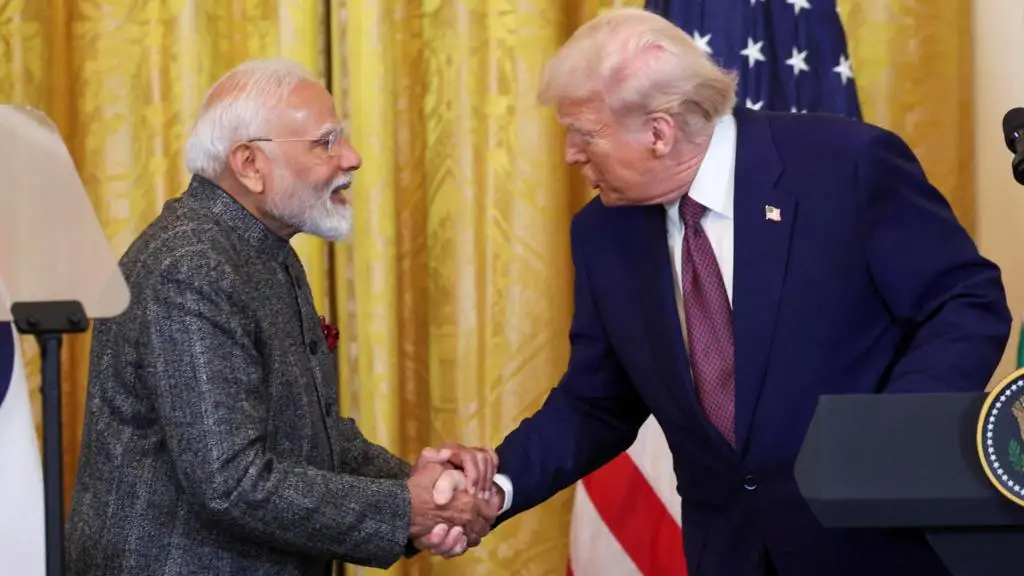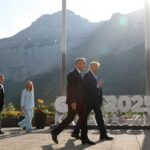Indian Prime Minister Narendra Modi became the fourth world leader to visit U.S. President Donald Trump at the White House since the start of Trump’s second term. Their meeting on Thursday underscored the growing ties between India and the United States, with both leaders exchanging warm words and unveiling new initiatives for economic and security collaboration. However, contentious trade issues, including Trump’s “reciprocal tariffs” policy, were largely avoided in public remarks.
A ‘Mega’ Partnership: Modi Echoes Trump’s Slogan
Trump and Modi have often been described as political allies, with some media dubbing their relationship a “bromance.” Their latest meeting reinforced that perception, as the two leaders heaped praise on each other.
Modi, addressing Trump through a translator, borrowed from Trump’s well-known “Make America Great Again” (MAGA) slogan, proposing a similar vision for India. “The people of America are aware of President Trump’s motto, ‘Make America Great Again’ or MAGA. Borrowing an expression from the U.S., our vision for a developed India is to ‘Make India Great Again,’ or MIGA. When America and India work together, when it’s MAGA plus MIGA, it becomes mega – a mega partnership for prosperity.”
Trump welcomed Modi’s comments, emphasizing their shared approach to governance. “Prime Minister Modi is a great leader, and he understands the importance of putting his country first. That’s something we both do very well.”
Trade Tensions And India’s Concessions
Despite their public camaraderie, economic disputes remain a sticking point. Trump has long criticized India’s high tariffs on American goods, reportedly calling Modi the “king of tariffs.” However, their meeting yielded a new “framework” aimed at addressing trade disparities.
“Prime Minister Modi and I have agreed that we will be in negotiations to address the long-running disparities,” Trump said. “But really, we want a certain level of playing field, which we really think we’re entitled to.”
To ease tensions, Modi announced India’s commitment to increasing bilateral trade, setting a target of $500 billion by 2030, more than doubling the current $129.2 billion trade volume. The Indian leader also pledged a “new scale and scope” for economic cooperation, particularly in artificial intelligence, energy, and space exploration.
Additionally, India signaled its willingness to increase imports of U.S. oil and gas. “The prime minister and I also reached an important agreement on energy that will restore the United States as a leading supplier of oil and gas to India,” Trump noted. “It will be, hopefully, their number one supplier.”
A Strategic Infrastructure Vision
Beyond trade, Trump highlighted a new infrastructure initiative that would link India to the U.S. and key allies, seemingly in response to China’s Belt and Road Initiative.
“We agreed to work together to help build one of the greatest trade routes in all of history. It will run from India to Israel to Italy and onward to the United States, connecting our partners by ports, railways, and undersea cables,” Trump explained.
This initiative appears to be an extension of the India-Middle East-Europe Economic Corridor (IMEC), announced in 2023. The corridor, involving countries like the United Arab Emirates, Saudi Arabia, and Greece, faces uncertainty due to the ongoing Israel-Gaza conflict. Nevertheless, Trump expressed confidence in the plan’s success, saying it would “keep the United States as the leader” in global trade.
Security And Terrorism Take Center Stage
While much of the discussion was expected to focus on countering China’s influence, security concerns related to terrorism took precedence. Trump confirmed his administration’s approval to extradite Tahawwur Rana, a Pakistani Canadian convicted of supporting terrorist activities, to India. Modi praised the move, likening the 2008 Mumbai attacks to “genocide.”
“India and the U.S. will stand strongly together in the fight against terrorism,” Modi declared.
Trump also confirmed increased military sales to India, amounting to “many billions of dollars,” while pledging closer counterterrorism cooperation. “In addition, the United States and India will be working together like never before to confront the threat of radical Islamic terrorism – a threat all over the world.”
Despite these commitments, Modi himself has faced accusations of turning a blind eye to anti-Muslim violence in India, raising questions about his rhetoric on combating extremism.
Ukraine Conflict Clouds Talks
While the meeting was centered on U.S.-India relations, Trump repeatedly faced questions about his recent discussions with Russian President Vladimir Putin regarding the war in Ukraine. Trump claimed he had engaged in a “lengthy and highly productive phone call” with Putin and had later spoken with Ukrainian President Volodymyr Zelenskyy. His comments, however, aligned with Russian narratives about NATO’s expansion, a stance that could unsettle European allies.
“Russia has gotten themselves into something that I think they wish they didn’t. If I were president, it would not have happened,” Trump asserted. “Now, Russia’s taken over a pretty big chunk of territory. And they also have said from day one, long before President Putin, they’ve said they cannot have Ukraine be in NATO.”
While Trump dodged questions about whether Russia would concede occupied territory, his remarks suggested skepticism about Ukraine regaining lost land. Modi, meanwhile, remained silent on the matter, avoiding any direct stance on the conflict.
The Modi-Trump meeting reaffirmed the deepening U.S.-India relationship, with both leaders pledging greater collaboration in trade, security, and infrastructure. However, trade tensions remain unresolved, and Trump’s evolving stance on global conflicts like Ukraine could have broader geopolitical implications.






